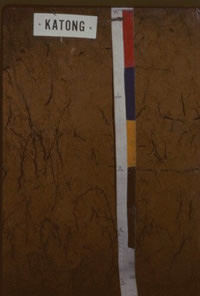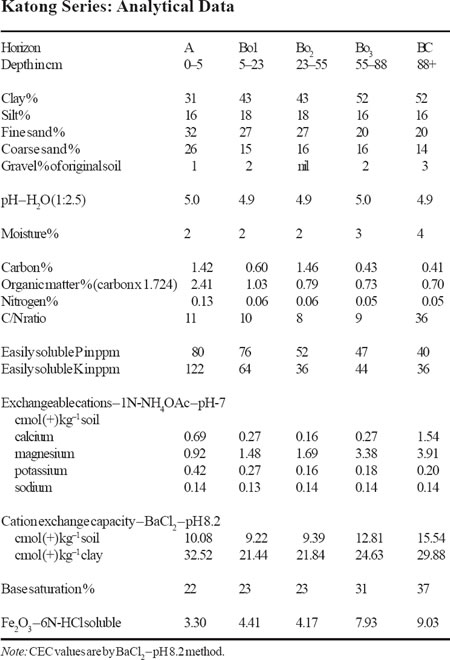Soil Profiles: Katong
Katong Series
The Katong Series is a member of the Munchong Family which is a very fine, kaolinitic, isohyperthermic, red-yellow Tipik Tempalemoks. It is developed over quartz diorite or quartz andesite parent material. The soils have brown to dark brown fine sandy clay loam A horizons and yellowish brown to strong brown clayey B horizons. The soils occur on rolling to hilly and steep terrain and are often deep but pieces of weathered quartz andesite or trachyandesitic tuff may be encountered at depths below one metre.
Type Location
The Katong Series was established in the Ulu Tembeling District of north-east Pahang by Libby (1964). The above pedon was described at a hill cutting at the 1133/ milestone Jerantut-Temerloh road. The pedon was described by Law (1964) on a 14° slope in hilly terrain. Location: Topographic Sheet 4060, 3°51’55” N, 102°23′ E (Grid Reference 4060 – 877273 m).
Range in Characteristics
The A horizon is often a brown to dark brown (7.5YR4/5, 10YR4/3) with fine sandy clay loam or clay loam textures. The oxic B horizons are often uniform to depths of one metre. They range in colours from yellowish brown to strong brown (10YR5/6 to 7.5YR5/6–5/8) in the major part of the B horizon. At depths the colours become yellowish red (5YR5/8) with medium distinct red mottles. Textures are clayey with about 40–80% clay and about 20% fine sand. The structures are moderate medium subangular blocky and consistence friable. Often thin patchy coatings are found on ped faces possibly indicating degraded clayskins. Occasionally a few petroplinthite concretions occur in the profile. At depth below one metre (depending on the slope) pieces of weathered rock fragments occur in the profile.
Competing Soils and Their Differences
The predominantly browner hues of the Katong Series makes the soil resemble soils such as Munchong Series and Jerangau Series. It is quite easily distinguished from the other Oksanah such as Segamat Series, Senai Series and Sungei Mas Series. Admittedly it is quite difficult to distinguish the Katong Series from the Munchong Series and Jerangau Series. The Munchong Series is derived from iron rich shale and has slightly weaker structures while the Jerangau Series is derived from granodiorite may be slightly more sandy. The Jerangau Series also has an ECEC of less than 1.5 cmol (+) kg–1 clay. One other feature which many be used is the fact that the Katong Series is developed over andesite, andesitic tuffs and trachyandesitic tuffs and is often closely associated with the Segamat Series while the Munchong Series occurs in areas of sedimentary rocks. The Katong Series is also often a shallower soil and is predominantly mapped on hilly to steep slopes (24–50% or 12–15° slopes)
Setting
The Katong Series soils occur typically on somewhat steep terrain (24–50% or 12–25° slopes). The depth of the profile is often closely related to the slope – being shallower on the steeper slopes. The soils are commonly only about a metre (3 feet) deep where pieces of weathered rock fragments are encountered. They occur at elevations not exceeding 100 metres (300 ft) although they may occur on higher altitudes which have not been surveyed to-date.
Principal Associated Soils
The Katong Series has been mapped in association with the Segamat Series. In the past the distinction between Segamat and Katong has not been well defined. This is particularly true where the colours are strong brown. In the redefinition here a soil would be Katong where 7.5YR hues or yellower dominate the upper part of the profile to a depth of at least 50 cm i.e. the Katong Series may only have 5YR hues below 50 cm depth. The soils of the Segamat Series would therefore have redder hues, heavier textures and weaker structures and a lower ECEC.
Drainage and Permeability
The Katong Series is a well drained soil. Permeability is good.
Use and Vegetation
The soils of the Katong Series have been mainly planted with rubber and oil palm. Rubber is by far the dominant crop on the steeper slopes. In Pahang and north Johore some of the areas with these soils are still under primary Lowland Dipterocarp Forest.
Distribution and Extent
Like the Segamat Series the Katong Series is closely associated with the belt of the volcanic tuffs and lavas referred to as the Pahang Volcanic Series. These soils to-date have only been mapped in Central Pahang – in the Jengka Triangle, Ulu Tembeling and around Jerantut and in north Johore. It is estimated that these soils occupy about 32,000 ha (80,000 acres) of the areas having slopes of less than 38% (20°). With the redefinition used above the extent of the Katong Series may be greater.
Series Established
This soils was established during the Reconnaissance Soil Survey of North-East Pahang Libby (1964) in the Lepar Valley in Pahang. The source of name is Sungei Katong, Pahang.
Remarks on Classification
The Katong Series is classified here according to the Malaysian Soil Taxonomy – Second Approximation (Paramananthan 1998) as a member of the very fine, kaolinitic, isohyperthermic, red-yellow family of the Tipik Tempalemoks. They are classified here as soils with an oxic horizon which has moderate structures and an ECEC of more than 1.5 cmol (+) kg–1 clay. It must be pointed out here that the pedon and the analytical data used in this paper were made a long time ago. In particular the analytical methods are not those as required in the Malaysian Soil Taxonomy and care must be taken when interpreting these results. The classification offered here therefore is somewhat tentative until better data is available. In the Keys to Soil Taxonomy – Eighth Edition (Soil Survey Staff 1998) the Katong Series would probably be Typic Hapludox. In the FAO/UNESCO Soil Map of the World – Revised Legend (FAO 1990) the Katong Series would be classified as Haplic Ferralsols.
Suitability for Agriculture
The most serious limiting factor of this soil is the terrain and the depth of soil. The soil is also well drained and hence moisture can be a problem if droughts occur in the area. Rubber is probably the best crop on these soils. Fruit trees may also do well on these soils.



